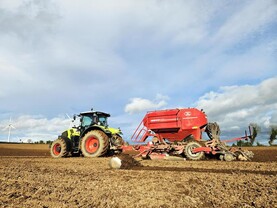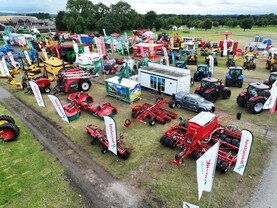Every now and again, a new product comes along that surprises in both its simplicity and ingenuity. The Trakjak, designed and built by Pauric Fay from Cootehill, Co Cavan, is one such product.
Pauric recently picked up an award at the LAMMA Show in Britain for his Trakjak. The Trakjak was the winner of the Farm Machinery and Equipment Innovation Award.
The Trakjak is a device that uses the lower lift arms of the tractor to jack itself off the ground. Pauric designed it principally with safety in mind but it also had to be simple and easy to use.
Pauric explains: “I saw the need for something safe to use to jack up the rear of a tractor. There are no real designated jacking points on a tractor like you would see on a car. And there’s too much guesswork with setting up ordinary jacks.”
Typically, a conventional bottle jack is used to jack each side of the rear of a tractor individually. Often, timber blocks are needed to compensate for the short height of bottle jacks. Unless the workshop is organised and tidy, this can be a task in itself to locate the appropriate blocks.
Positioning of the bottle jack can be precarious enough. Concrete solid and level ground is needed for safe jacking. Wheels also need to be chocked to stop the tractor rolling and toppling off the jack.
As Pauric says, it can be hard to position a jack correctly and with confidence under a tractor. Ideally, anything being jacked needs to be jacked at its outermost point. The large nature of tractors’ rear wheels and ancillary equipment bolted onto the rear-axle housing can make it difficult or altogether impossible to jack at the outermost positions.
The hitch is the usual jacking point but is not very wide. This means that jacking up the side of a tractor is usually done close to the tractor’s centre line. Not the most stable jacking point, requiring careful positioning of the jack and axle stands at the ready.
Pauric’s Trakjak, on the other hand, couldn’t be simpler. Reverse the tractor over the Trakjak, hook the lift arms into the brackets and pins provided before raising the tractor’s lift arms. The rear of the tractor is completely jacked off the ground.
Level surface
Naturally, a level concrete or similarly hard surface is required for safe operation. Two stands at the rear are lowered to the ground to allow the weight to be taken off the lift arms. Simple and safe.
How does the Trakjak work? “We adapted the law of the lever in designing the Trakjak,” explains Pauric. The wheels of the Trakjak remain on the ground at the front end and lift arms attach to the rear.
In the middle is a large solid bar with two heavy duty sleeves or bushings that can rotate on the bar.
As the tractor’s lift arms are raised, this bar and sleeves come up against the underside of the tractor’s hitch. The sleeves can be slid inwards or outwards to suit different hitch designs.
The entire Trakjak effectively pivots on the central bar and sleeves under the hitch. As the lift arms rise, the entire frame pivots, pushing the front wheels of the Trakjak down while raising the tractor off the ground.
In practice, the system and tractor is incredibly stable with its rear wheels completely off the ground. Combined with solid rubber wheels on the Trakjak, the tractor is stable enough to allow the tractor to be driven on suitable terrain, such as level concrete.
The tractor’s rear wheels can be safely left at one location while the tractor is driven to another. That may be to another shed to fit row crops or to a wash bay.
The ability to wash a tractor without its rear wheels is important, as Pauric points out. “Tractor transmissions and hydraulic systems have become very sophisticated. Being able to wash down the transmission before changing hydraulic and transmission filters greatly reduces contamination risks at servicing,” he says.
Pauric adds that it helps to keep workshops cleaner by allowing them to be washed off before coming in for work. “You would often see a wheelbarrow full of dirt where a tractor was stripped down in a garage for repair.”
The Trakjak is adaptable to nearly any tractor, according to Pauric. Because a tractor’s lift arm range is so broad, Pauric found that just two settings on two elements of the Trakjak were enough to cater for all tractors.
There are two settings for the pivot bar and two settings for lift arms and that’s about it. Rear stand heights are adjustable to suit whatever height the user requires.
Versatile enough to suit the broadest range of tractor makes and models, Pauric produces just one model of Trakjak. Sitting on the ground ready for action, just 12in of ground clearance is needed to reverse into and yoke up to the Trakjak.
Standard equipment with the Trakjak is an A-frame that connects the tractor’s pickup hook to the Trakjak’s rear stands. This feature locks the Trakjak in place to allow the tractor’s lift arms to be removed.
“A lot of tractors have the lift arms attached to the trumpet housing half axles. If you want to remove the lift arms and axles to inspect or work on the tractor’s brakes, then you can with an A-frame attachment,” explains Pauric.
Pauric has also developed an innovative half-axle removal tool, which we may cover at a later stage.
At around 350kg in weight, the Trakjak is solidly constructed. The Trakjak is proof load tested for 12t, so it should cater for even the biggest of conventional iron horses. Each Trakjak come with its own cert to keep insurance firms happy.
The price of the Trakjak is €2,400, plus vat. This is perhaps outside of the scope of ordinary farmers but it is an option worth considering where multiple wheel changes are made throughout the year. It is a definite asset in a tractor garage or even a tyre garage. It is not a product that wears out or goes out of date so once purchased it is a Trakjak for life.
Pauric Fay can be contacted on 087-2678902 or emailed at pauricfay@gmail.com.






 This is a subscriber-only article
This is a subscriber-only article












SHARING OPTIONS: